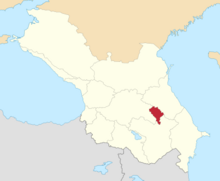Zakatal Okrug
Zakatal Okrug
Закатальский округ | |
|---|---|
 Coat of arms | |
 The Zakatal Okrug in the Caucasus Viceroyalty | |
| Coordinates: 41°38′1″N 46°38′36″E / 41.63361°N 46.64333°E | |
| Country | Russia |
| Political status | Okrug |
| Region | Caucasus |
| Established | 1859 |
| Abolished | 1918 |
| Area | |
| • Total | 4,590 km2 (1,770 sq mi) |
| Population (1916) | |
| • Total | 92,608 |
| • Density | 20/km2 (52/sq mi) |
| History of Azerbaijan |
|---|
 |
|
|
The Zakatal Okrug, also known as Zakatali or Zakataly (Russian: Закатальский округ), was a special administrative okrug (county) of the Caucasus Viceroyalty of the Russian Empire, part of the Tiflis Governorate from 1893 to 1905. The administrative centre of the district was the city Zakataly (Zaqatala), and it corresponded to most of the contemporary districts of Balakan, Zaqatala and Qax of Azerbaijan. The Zakatal Okrug was established from the territories of the erstwhile Free Jamaats of Jar-Balakan, bordering the Tiflis Governorate to the west, the Elisabethpol Governorate to the south and the Dagestan Oblast to the north. The district was unique in that it was the smallest independent (not part of any province or region) administrative unit of the Russian Empire, similarly to the Sukhumi Okrug.[1]
History[]
The district was originally established under the name Belokan in 1842, within the Georgia-Imeretia Governorate, two years after it was renamed to Jaro-Belokan. The autonomous status of the district was confirmed in 1846, leading to its renaming to Zakataly in 1860 and its placement into the temporary administration of Dagestan during which its administration was organised into a military council, of which the chief was the head of the district, concurrently with Dagestan.[2] In 1881, an independent administration was introduced. The Zakatal Okrug was incorporated into the 'civilian' administration of the Tiflis Governorate from 1893 until 1905 when was removed and placed directly under the Viceroy of the Caucasus.[3]
The social structure of the Zakatal Okrug was multi-layered in its patriarchal-clans which were involved in "mountain feudalism", which became muddled by growing ethno-nationalism and the social differences they bore. The Free Jamaats (Society) peoples were the collective owners of the lands in which the Georgians and Azerbaijanis lived, for which the latter paid tax to them. In 1863, a rumor circulated that the administration of Zakataly was planning to emancipate the Georgians and Azerbaijanis from their financial obligations to the Free Jamaats peoples, leading to an anti-Russian uprising of its Dagestani inhabitants. The uprising became elevated by the declaration of jihad (holy war) until its suppression by local troops assisted by Azerbaijani volunteers.[1]
Following the Russian Revolution, most of the district was incorporated into the Azerbaijan Democratic Republic and transformed into the Zaqatala Governorate, despite also being claimed by neighboring Georgia, however, the authorities of both nations agreed to resolve the territorial dispute over Zakataly strictly by peaceful means.[4][2][5]
Despite the Russian SFSR recognising the Zakatal Okrug as part of the Democratic Republic of Georgia by the Treaty of Moscow (1920), after the latter's Sovietization a mixed commission of Georgians, Azerbaijanis with a Russian chairman resolved the territorial dispute in favour of Soviet Azerbaijan. During the administrative-territorial reforms of the 1920s, the Zakataly district was separated into the raions of Balakan, Zaqatala and Qax.
Economy[]
The main occupations of the predominantly Sunni population included cattle breeding, agriculture, viticulture, picking fruits (mainly walnuts), handicrafts and silkworm breeding.[1]
Administrative Divisions[]
The uchastoks (sub-counties) of the Zakatal Okrug were:[6][1]
- Aliabad (Russian: Алиабадский участок)
- Kakh (Russian: Кахский участок)
- Belokan (Russian: Белоканский участок)
- Jaro-Mukhakh (Russian: Джаромухахский участок)
The so-called Gornye magaly (Mountain Quarters) along the headwaters of the Samur (Tsakhur villages) were removed from the district in 1860.
Demographics[]
As of 1897, 84,224 people populated the okrug: Avars constituted the majority of the population, with Azerbaijanis as the second largest ethnic group. Significant minorities consisted mainly of Ingiloy Georgians and Dargins.
Ethnic groups in 1897[7][]
| TOTAL | 84,224 | 100% |
|---|---|---|
| Avars | 31,670 | 37,6% |
| Azerbaijanis | 28,950 | 34,4% |
| Georgians | 12,389 | 14,7% |
Caucasian Calendar of 1917[]
The 1917 Caucasian Calendar which produced statistics of 1916 indicates 92,608 residents in the Zakatal Okrug, including 48,323 men and 44,285 women, 86,128 of whom were the permanent population, and 6,480 were temporary residents:[8]
| Nationality | Center | Rural | TOTAL | |
|---|---|---|---|---|
| Azerbaijanis[a] | 774 | 42,582 | 43,356 | 46.8% |
| North Caucasians[b] | 1,068 | 40,712 | 41,780 | 45.1% |
| Georgians[c] | 204 | 4,370 | 4,574 | 4.9% |
| Armenians | 2,165 | 365 | 2,530 | 2.7% |
| Russians | 270 | 56 | 326 | 0.4% |
| TOTAL | 4,505 | 88,103 | 92,608 | 100.0% |
Notes[]
References[]
- ^ a b c d "ЗАКАТАЛЬСКИЙ ОКРУГ • Большая российская энциклопедия - электронная версия". bigenc.ru. Retrieved 2021-12-16.
- ^ a b Janeliże, Otʻar (2018). The Democratic Republic of Georgia, 1918-1921. Tbilisi. pp. 52–53. ISBN 978-9941-8-0096-2. OCLC 1110424382.
- ^ Tsutsiev, Arthur (2014), Atlas of the Ethno-Political History of the Caucasus, New Haven and London, pp. 172–174, ISBN 978-0-300-15308-8, OCLC 884858065, retrieved 2021-12-16
- ^ Yilmaz, Harun (2009-06-01). "An Unexpected Peace: Azerbaijani–Georgian Relations, 1918–20". Revolutionary Russia. 22 (1): 37–67. doi:10.1080/09546540902900288. ISSN 0954-6545.
- ^ Daushvili, Aleko (2012-01-01). "The Democratic Republic of Georgia: Struggle for Independence 1918-1921".
{{cite journal}}: Cite journal requires|journal=(help) - ^ Кавказский календарь .... на 1913 год (in Russian). Tbilisi. pp. 271–317.
- ^ "Демоскоп Weekly - Приложение. Справочник статистических показателей". Demoscope.ru. Retrieved 2013-10-05.
- ^ Кавказский календарь .... на 1917 год (in Russian). pp. 357–358.
- Russia geography stubs
- Caucasus Viceroyalty (1801–1917)
- Oblasts of the Russian Empire
- Tiflis Governorate
- Modern history of Azerbaijan
- 19th century in Azerbaijan